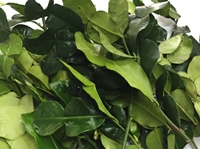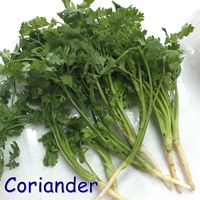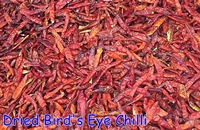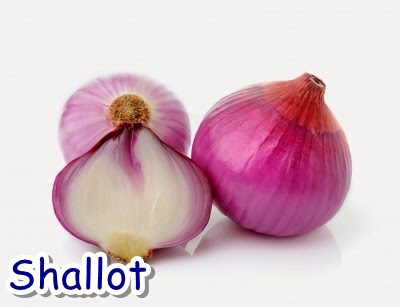They are some examples of Thai ingredients widely in Phuket Easy Thai Cooking.
| Herbs, Pastes, Sauce, Condiments, Vegetables and Spices | |||
| Image | Thai name | English name | Description and use |
| Gui chai | Chinese chives, Garlic chives | Closer in flavour to garlic. Used in stir fries such as pad Thai. | |
 |
Bai makrut | Kaffir lime leaves | Kaffir lime leaves are widely used in spicy Thai soups and curries, either cooked whole, together with the dish, and/or finely shredded and added before serving. |
| Bai toei | Pandan orscrewpine leaves | This sweet smelling leaf is used for flavouring different sweet snacks/desserts. It is also used in the well known dish Kai ho bai toei, deep fried chicken wrapped in pandanus leaves, as well as to stuff the belly of barbecued fish | |
| Horapha | Thai sweet basil | It is used in different curries such as red and green curry and often also served separately. | |
 |
Kha | Galangal | The perfume-like scent and flavour of the galangal root is characteristic for many Thai curries and spicy soups. |
| Kha min | Turmeric | It's a ginger family, often used in Thai dishes and to impart color to mustard condiments. slightly hot peppery flavor and a mustard smell. | |
 |
Khing | Ginger | The same family of Galangal and Turmeric, slightly hot peppery. |
| Krachai | Fingerroot | This root has a slightly medicinal flavour and is used in certain meat dishes and curries. | |
| Kaphrao | Holy basil | Holy basil has a distinctive scent of clove and reddish tipped leaves. It is used, for instance, in the well-known Ka phao kai (minced chicken fried with basil) | |
 |
Krathiam | Garlic | Garlic is used in many Thai dishes and salad dressings. |
 |
Phak chi | Coriander/cilantro | The leaves and root are seen often as a garnish with many Thai dishes. It is indispensable for Tom yam soup. |
 |
Phrik chi fa | Chilli spur pepper | It is a medium-sized chilli and less spicy than the phrik khi nu, it is often added to stir fried dishes and curries as a kind of "vegetable". Either red, yellow, or green in colour. |
 |
Phrik khi nu | Bird's eye chilli | This small chilli is one of the spiciest and used extensively in Thai cooking. The Thai name literally translates to "mouse-dropping chilli" |
| Phrik khi nu suan | Garden mouse dropping chilli | This variety of the phrik khi nu is even smaller and even more spicy. | |
 |
Phrik Thai on & Phrik Thai dam |
Fresh peppercorns & Black pepper | Thai cuisine often uses fresh (green) peppercorns in stir fried dishes and in certain curries such as Kaeng pa (so-called Jungle Curry). |
 |
Takhrai | Lemon grass | Used extensively in many Thai dishes such as curries, spicy soups and salads. |
 |
Op choei | Cinnamon | Used in certain meat dishes, most notably in Matsaman curry. |
| Nga | Sesameseed | The oil from the sesame seed is not really used in Thai cuisine. The seeds (black and white sesame) are mainly used whole in certain deep fried desserts | |
| Phong kari | Yellow curry powder | Thai curries are nearly always made with fresh curry pastes. Yellow curry powder is used when making peanut sauce for Satay, as well as in stir-fried dishes called phat pong kari. | |
 |
Phrik haeng | Dried chillies | Dried chillies can be used in many ways in Thai cuisine: either ground into chilli flakes and used as a condiment, as an ingredient for Thai curry pastes, in chilli pastes and dips, or deep-fried and served whole with certain dishes. |
| Phrik pon | Chillies powder | Crushed dried chillies, used extensively in Thai cuisine, for instance in lap, and for making several types of nam chim and nam phrik. | |
| Kapi | Thaishrimp paste | Fermented ground shrimp and salt. It has a pungent aroma. It is used in red curry paste, in the famous chili paste called nam phrik kapi. | |
| Khrueang kaeng | Thai curry paste | Thai curry paste can be made fresh at home or bought freshly made at markets in Thailand. Most curry paste will be a ground mixture of fresh or dried chillies, various spices and herbs, and other ingredients such as shrimp paste and salt. | |
 |
Hom daeng | Shallot | Shallots, not onions, are essential for Thai cuisine. They are used for making Thai curry pastes, salads, and certain condiments and pickles. |
| Kalam pli | White cabbage | In Thai cuisine, cabbage is often served raw on the side with Thai salads such assom tam or lap, steamed or raw with nam phrik, or boiled in soups and curries. | |
| Khilek | Senna siamea | The leaves, tender pods and seeds are edible, but they must be previously boiled and the water discarded. One of the most well-known preparations is Kaeng khilek | |
 |
Makhuea phuang | Pea eggplant | This pea sized eggplant is often used in curries and is indispensable in Nam phrik kapi, a chilli dip containing shrimp paste, where it is used raw. |
 |
Makhuea pro | Thai eggplant | About the size of a ping pong ball, these eggplants are used in curries or stir-fries, but they are also eaten raw with Nam phrik (Chilli dips). |
 |
Makhuea thet | Tomato | Literally meaning "foreign eggplant", it is used in salad such as Som tam, as an ingredient in stir-fries such as in Thai fried rice. |
| Phak bung | Morning-glory orwater spinach | The large variety (Phak bung chin) is mostly eaten stir-fried or in soup. The small variety (Phak bung na) is generally served raw with Som tam or with Nam phrik. | |
| Taengkwa | Cucumber | Typical Thai cucumbers are small. Eaten raw with Nam phrik or as a Som tamingredient. | |
| Thua fak yao | Bean sprouts | It is often eaten in soups and stir-fried dishes. Thais tend to eat bean sprouts raw to semi-raw, for instance in Phat Thai noodles where it is either sprinkled on top of the finished dish raw or added into the pan for one quick stir before serving | |
| Man thet | Sweet potato | Man thet (literally meaning "foreign tuber") is popularly also known as man daeng (red tuber) boiled pieces are eaten as a snack or used as an ingredient for desserts. | |
| Man kaeo | Jicama | This tuberous root is mostly eaten raw with sugar, as if it was a fruit. | |
| Pheuak | Taro | Usually boiled pieces are an ingredient of a variety of desserts. Slices of deep fried taro are also popular as a snack. | |
| Dok anchan | Clitoria ternatea | Can be eaten raw or fried, but mostly it is used to make a blue food colouring to colour rice or sweets, like Khanom dok anchan. | |
 |
Het fang | Volvariella volvacea ("Straw mushroom") | |
| Het hom | Lentinula edodes or Shiitake | ||
| Het hu nu | Cloud ear fungus | ||
| Het hu nu khao | White jelly fungus | ||
| Het khem thong | Golden needle mushroom | ||
| Het nang fa | Lentinus sajor-caju (or Pleurotus sajor-caju) | ||
 |
Makham | Tamarind | The pulp is used to give a pleasant sour taste to some soups, curries and Pad Thai. Also used to make sweets and refreshing drinks. |
 |
Malako | Papaya | Traditionally eaten mainly while green and unripe as a main ingredient in Som tam. |
| Mamuang | Mango | Often eaten green and sour as an ingredient in salads and sauces, but also as a ripe fruit | |
 |
Manao | Lime | Indispensable to Thai cuisine, it serves as the main ingredient for adding acidity to Thai dishes such as with Tom yum and Larb. It can also be eaten chopped together with the peel in dishes. |
| Maphrao | Coconut | The young nut is popular as a refreshing drink. Coconut milk is extracted out of the grated flesh of the ripe nuts and is used in a number of dishes and curries, especially in Southern Thailand. | |
| Saparot | Pineapple | It can also be used in cooking, such as baked rice pineapple. | |
| Som-o | Pomelo | In Thailand, pomelo is often eaten dipped into a spicy mix of dried chilli flakes, sugar and salt. It can also be used in spicy Thai salads such as Yam som-o. | |
| Khao hom mali | Jasmine rice or Thai fragrant rice | This long-grained variety of rice, with its nutty aroma and a subtle pandan-like flavour, originates from Thailand and now forms the bulk of Thailand's rice crop. | |
| Khao niao | Glutinous rice orsticky rice | The main type of rice traditionally eaten in the northeast and north of Thailand. | |
| Khao niao dam | Blackglutinous rice | With a nutty taste, it can be mixed together with steamed white rice and eaten with savoury dishes or served sweetened with coconut milk. | |
| Paeng khao chao | Rice flour | Used mainly in desserts and as a thickening agent | |
| Paeng man sampalang | Tapiocaflour | Used mainly in desserts and as a thickening agent | |
| Khanom chin | Thai rice vermicelli | Fresh rice vermicelli made from fermented rice. It is commonly seen as a noodle to go with certain spicy soups and curries, but it is also popular with som tam and other Thai salads. | |
| Sen lek | Narrow rice noodle | Narrow, flat rice noodles; used in such dishes as pad Thai and in noodle soups. Its full name would be kuai tiao sen lek. | |
| Sen mi | Rice vermicelli (thin) | Similar to the Chinese rice vermicelli; used in noodle soups. Its full name is kuai tiao sen mi. | |
| Sen yai | Cellophane noodles orglass noodles | Extremely thin noodles made from mung bean flour which turns transparent when moist. It can be used in salads and soups, or stir-fried. | |






